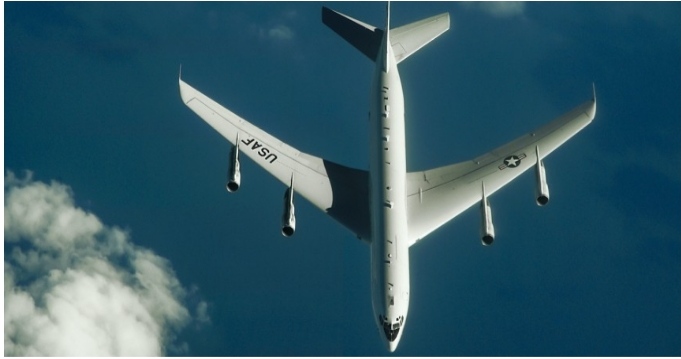US Space Force On The Move : To Take on an Air Force Surveillance Mission

A U.S. Air Force E-8C Joint Surveillance Target Attack Radar System flies over the U.S. Central Command area of responsibility Dec. 14, 2020. The Space Force is now taking on the JSTARS mission of providing ground surveillance, but will do it with a space-based system.
A few years ago, the Air Force began looking at ways to replace its JSTARS surveillance aircraft, to ensure it could keep providing a clear picture of ground movement when the fleet of outfitted Boeing 707s encounters a highly contested environment. The Space Force has now taken on that challenge.
Chief of Space Operations Gen. Jay Raymond announced that the service is “building out” a Ground Moving Target Indicator, or GMTI, that would operate from space.
“ Now the Space Force, has a program that we’re building GMTI for space, from space. And so you will see that’s another area where we’re actively working to be able to provide that capability,” Raymond said at the McAleese FY2022 Defense Programs Conference
GMTI in open-source publications is known for enabling the intelligence community and DOD to track moving vehicles and people.
“Ground Moving Target Indicator is the ability to continuously track moving vehicles on the ground—knowing where everything is now, but also where it was in the past, and using that to predict where it will be in the future,” said John Ferrari, a retired Army two-star and visiting fellow at the American Enterprise Institute.
“For the military, seeing a vehicle that may be a missile launcher on the road and then rewinding the ‘tape’ to see if it left a missile base, seeing the route it takes, and then predicting where you may want to hit that vehicle is extremely valuable,” Ferrari said.
JSTARS, U2s, and Global Hawks all have GMTI capability, said Sarah Mineiro, senior director for space strategy at Anduril Industries.
“Space Force has not previously had a significant role in GMTI, leaving those responsibilities to the intelligence community or airborne assets procured by the Air Force, and to some extent the Army,” said Mineiro, who helped craft the legislation establishing the Space Force in her previous role on the House Armed Services Committee.
“Recently, there has been increasing discussion about the role that space-based assets could contribute to the GMTI, both directly and as a product of data fusion,” Mineiro said. “As Space Force continues to organize, train, and equip to provide joint warfighters with space-based capabilities, the Space Force may be reassessing its contributions to this capability area.”
The Air Force’s efforts to further tweak the capability for space-based use, and that the Space Force would become its operator to collect and feed ground-based surveillance, was not publicly reported before Wednesday. It represents one of the ways Raymond is trying to declassify information to help the public better understand the service’s mission, said Space Force spokeswoman Col. Catie Hague.
“The space-based GMTI system will replace a portion of the JSTARS sensing capability,” Hague said. It “will surpass the range limitations of current air platforms and will provide capabilities in contested and non-contested environments.”
Space-based GMTI is not yet operational and there are no program schedule dates set as of yet, a Space Force official told Defense One.
“[Space Force] guardians will operate the satellites once there is an operational capability on orbit, and that capability will support all combatant commands,” the official said.



